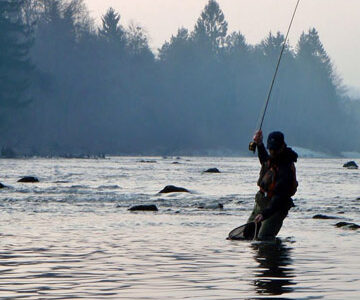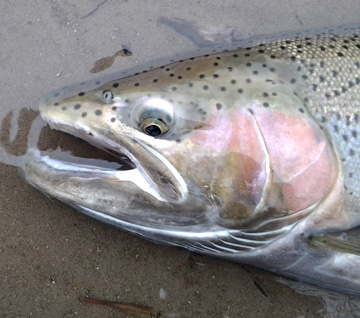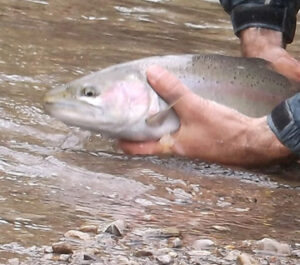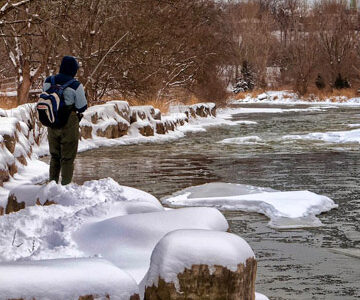Join our mail list and receive New Product Updates, Seasonal Specials, Promos and more!

Join our mail list and receive New Product Updates, Seasonal Specials, Promos and more!



Steelhead fishing in Michigan is very popular, with fish starting to enter the rivers in March. Runs hit their peak in April and fishing can still be good up until the end of May. Some of the best steelhead rivers in Michigan are the The Pere Marquette River and Big Manistee River. Both rivers offer excellent steelhead adventures. The Pere Marquette is a smaller stream, with many nice pools that hold good numbers of fish. The Big Manistee River is a larger river and is best fished with a drift boat so anglers can cover more water in search of active fish.
The most common patterns that produce the majority of the trout, are egg sucking leeches, imitation egg patterns, nymphs and stoneflies. Caddis and mayfly nymphs have also been known to be effective, especially in low and clear water conditions. Early season fishing is best in the Pere Marquette River since it warms faster than the deeper Big Manistee River. Although the fishing can be exceptional on the Big Manistee, especially during the peak runs in April.
 Another steelhead river in Michigan is the mighty Muskegon River. This river has a very healthy run of both wild steelhead and stocked fish and the fishing can be hot, especially during the middle of April. Egg patterns, wooly buggers, nymphs and stoneflies once again are the most popular patterns used to entice these feisty fish into striking. When the water is low and clear and the fish are spooky, smaller presentations, such as beads and small nymphs are most productive. Some of the more popular fishing areas include the tailwaters of the Croton Dam, and fishing the tributaries, namely the Hersey River, Cedar Creek and Little Muskegon River.
Another steelhead river in Michigan is the mighty Muskegon River. This river has a very healthy run of both wild steelhead and stocked fish and the fishing can be hot, especially during the middle of April. Egg patterns, wooly buggers, nymphs and stoneflies once again are the most popular patterns used to entice these feisty fish into striking. When the water is low and clear and the fish are spooky, smaller presentations, such as beads and small nymphs are most productive. Some of the more popular fishing areas include the tailwaters of the Croton Dam, and fishing the tributaries, namely the Hersey River, Cedar Creek and Little Muskegon River.
Flyfishing late into April and May, can be a great time for steelhead fishing, especially after periods of rain, since hungry spawned out drop-backs steelhead are aggressively feeding. This time of year don’t be surprised if you hook into a bonus brown trout, the colours of these spotted beauties can be breathtaking. Give steelhead fishing in Michigan a try, with so many rivers and places to fish, it’s an anglers paradise. Good luck and tightlines.


Known as steelhead alley, trout fishing in New York state is primarily centered around Lake Erie’s tributary streams, which boasts large runs of this migratory trout. Steelhead numbers peak between October to April, with thousands of trout making yearly migrations upstream to spawn. Many avid anglers from nearby states, and Canada flock to these well known rivers and streams in hopes of tangling with these feisty and acrobatic fish.
The steelhead fishery in New York state is supported by stocking programs as well as natural reproduction. Thousands of steelhead are stocked in 9 major tributaries of Lake Erie, most notably and by far the most supported tributary being Cattaraugus Creek. Both Washington strain and Skamania steelhead are stocked. The Washington strain is considered a winter-run steelhead, running between October and April and is the most abundant steelhead in Lake Erie. Skamania steelhead are stocked to a lesser extent and are considered summer-run trout, and provide anglers with action as early as August and September.

Lake Erie steelhead average in size from 4-6 lbs, although fish in the 10 lb and mid-teens are not uncommon. The most common method of fishing, is drift fishing, either under a float or bottom bouncing. Baits used include, roe, worms, beads and flies. Float fishing with noodle rods, center pin reels and light line 4-6 lbs test is the most widely used gear. Many anglers use spinning gear for float fishing, as well as for casting small spoons, plugs and crankbaits. These lures can be very effective when trout are aggressive. Fly fishing is also popular with some anglers. Fly rods are generally 6-8 weight, and fly reels are usually large to avoid excessive line memory. Spey flies, woolly buggers, stonefly patterns and nymphs can all be very effective. Also egg imitation flies are very popular and can be deadly when steelhead are targeting this abundant river forage, especially in late spring.
Any stream that flows into Lake Erie can have steelhead runs, although the major runs occur in Cattaraugus, Canadaway, Chautauqua and Eighteen Mile Creek. These streams are the most heavily stocked, as well as many support natural reproduction, especially Cattaraugus creek. Other tributaries that receive good runs of steelhead include Buffalo, Cayuga, Cazenovia, Silver and Walnut Creek. Please be mindful of private property, many streams have very limited public access. Research the streams you would like to fish, talk with other anglers, visit tackle shops and become knowledgeable and you will quickly find that there are many public sections where you can fish. Get out there, enjoy and good luck! Catching a trophy steelhead is an experience like no other.


Fishing for steelhead in Pennsylvania is very popular in the spring and fall. One of the most exciting fish to catch, the mighty steelhead, known for it’s acrobatic leaps and reel screaming runs. They can truly get a fisherman’s adrenaline rushing.
The main techniques used to catch these feisty fish is fly fishing and drift fishing. For anglers that prefer fly fishing, fly rods in the 7 to 8 weight are most often used, weight forward floating fly lines of matching weight and a variety of trout flies. Woolly buggers, nymphs, stoneflies, egg imitations, egg sucking leeches and crystal buggers can all produce numbers of steelhead. Streamers are also deadly especially patterns with pink and white.
 Drift fishing is also a popular technique for steelhead, and generally uses long noodle rods, center pin or spinning reels, a float, and small sharp hooks, sizes 12, 14, 16 and 18. Small split shot is added to a light leader, usually a few inches apart so the bait bounces along the bottom in a natural presentation. The most common bait used is roe, although worms can also produce good steelhead numbers.
Drift fishing is also a popular technique for steelhead, and generally uses long noodle rods, center pin or spinning reels, a float, and small sharp hooks, sizes 12, 14, 16 and 18. Small split shot is added to a light leader, usually a few inches apart so the bait bounces along the bottom in a natural presentation. The most common bait used is roe, although worms can also produce good steelhead numbers.
Elk creek is one of the largest rivers in Pennsylvania and also one of the most popular. Some of the more well known steelhead spots include the mouth of Elk Creek, the Legion Hole and the Conrail Tubes on the lower sections of the creek. In the upper stretches, Foley’s End and Streuchen Flats are also very productive areas.
Walnut Creek is the second largest system in Erie Pennsylvania and also has a very good run of steelhead. The main access point and most popular fishing area is Walnut Creek Marina. This section can get very busy with fisherman, shoulder to shoulder especially during the peak time of the steelhead runs.
Twenty Mile is also a good steelhead stream. Access is along route 5 and most anglers fish the mouth area. Additional fishing opportunities can be found in a number of small streams that run by route 5. These include Raccoon, Godrey, Trout, Cascade, Four Mile, Seven Mile and Sixteen Mile creek.
Steelhead fishing in Pennsylvania is one of the most popular forms of fishing in the state, with many anglers coming from far and abroad. The fishery is one of the best along the shores of Lake Erie. Get out and try your luck, you might be rewarded with a trophy steelhead.


Fishing for steelhead in the winter can be quite challenging. It’s cold, river banks are icy, and gin clear conditions make fishing this time of year quite difficult. Steelhead are also less active and not overly aggressive. Winter trout will hold in the deeper pools in areas with minimal current so they don’t expend any excess energy. They will also sit tight to bottom or under cover. This time of year slow your presentation down, use light line and just enough weight to allow your bait to gently bounce along the bottom. Pay particular attention to your float as the slightest movement could be a strike.
 Dress warm during this time of year, as it’s easy to get uncomfortable standing on the banks of a frozen river, the upside, you will find yourself fishing for less pressured trout as you may be the only angler on the river. Proper footwear with good traction is also a must, since creek and river banks can be extremely slippery and icy during the winter months.
Dress warm during this time of year, as it’s easy to get uncomfortable standing on the banks of a frozen river, the upside, you will find yourself fishing for less pressured trout as you may be the only angler on the river. Proper footwear with good traction is also a must, since creek and river banks can be extremely slippery and icy during the winter months.
You also need to take extra care with your equipment, as one of the most frustrating problems steelheading during the winter is the guides of your rod icing up. Coat the guides with wax or vaseline prior to every outing to reduce the icing. Floats and leaders also have a tendency to ice up and this will greatly effect your drift, so stop and de-ice your float and line often. Also take extra care when choosing your drift locations, the edges of ice sheets can cut your line when you hook a trout and it begins to swim under the ice. An additional challenge when fishing for winter steelhead.
Best baits for winter steelhead are small spawn sacs in natural colours, beads, and egg imitation flies. Streamers can also be very effective if the trout are feeding on minnows. Woolly buggers and stoneflies have also been known to work, since winter trout can be very finicky. So when the temperatures start to drop, don’t put your steelhead gear away, give winter steelheading a try. Find a nice quiet stretch of river, enjoy the winter scenery and just be patient. You will be rewarded.

 Hooking into a “screaming chromer” is thrilling. This refers to the steelheads tendency to run and jump once hooked and pull line giving your drag a real work-out. In spring, steelhead move up rivers and creeks that feed the Great Lakes is great numbers. Once the season opens anglers will crowd well know holding pools where action can been non-stop all day. Most use noodle rods, rigged with light line 4-6lbs and either a float reel / centre pin reel or spinning reel. Float fishing with roe is the staple here and has proven to be the top producing tactic. Although the use of flies, such as wooly buggers, stoneflies and egg patterns are also effective. The main rivers attracting attention are those near urban centers, namely the Ganaraska River in Port Hope, the Credit River in Mississauga, the Grand River, the Niagara River, the Nottawasaga, Saugeen and the Maitland river. Average fish are between 4-6 lbs, although fish in excess of 20lbs are caught annually.
Hooking into a “screaming chromer” is thrilling. This refers to the steelheads tendency to run and jump once hooked and pull line giving your drag a real work-out. In spring, steelhead move up rivers and creeks that feed the Great Lakes is great numbers. Once the season opens anglers will crowd well know holding pools where action can been non-stop all day. Most use noodle rods, rigged with light line 4-6lbs and either a float reel / centre pin reel or spinning reel. Float fishing with roe is the staple here and has proven to be the top producing tactic. Although the use of flies, such as wooly buggers, stoneflies and egg patterns are also effective. The main rivers attracting attention are those near urban centers, namely the Ganaraska River in Port Hope, the Credit River in Mississauga, the Grand River, the Niagara River, the Nottawasaga, Saugeen and the Maitland river. Average fish are between 4-6 lbs, although fish in excess of 20lbs are caught annually.
Once the spring runs are over and the steelhead return to the Great Lakes, they can be caught all summer trolling the depths with a wide variety of lures. Although the most common lures, include spoons, like the Northern King and body baits. Colour patterns vary, although the most productive colour combinations seem to be green/silver, orange/silver, pink/silver and blue/silver. Any lure that mimics the baitfish in the area is usually a good bet and can be productive. In Lake Ontario, anglers generally troll their lures anywhere from 70ft to 250ft. Key trolling depths are dictated by the temperature. Generally 60 to 65C is the preferred summer target temperature. Having a temperature sensor on your cannon ball can eliminate a lot of the guess work, when targeting temperature bands, although experimenting and trial and error can be equally effective at locating active summer steelhead in Lake Ontario.
 Lake Erie is another great lake with a phenomenal steelhead fishery. In summer, the steelhead will be deep, and in Lake Erie this 60 to 80 ft. The same techniques apply with anglers generally trolling for steelhead using spoons and stick baits that mimic the available forage. Many anglers also use dipsy divers which can be used to bring your offerings down to the preferred depth without the use of expensive down rigger gear. While trolling for steelhead on Lake Erie, don’t be surprised if you catch a bonus walleye, as these aggressive fish will generally hold in similar areas to steelhead. Another critical factor when trolling for summer steelhead, besides the temperature is trolling speed. The most common trolling speed seems to be anywhere between 2-2.5 mph. Also take into consideration the wind direction while trolling as it can have a great effect on your trolling speed. The use of a drift bag is highly advantageous on days where controlling your speed may be a problem. Of course anytime you are targeting a predatory fish, like steelhead trout, look for bait balls. Anytime you are marking bait on your finder, usually the steelhead are not far behind.
Lake Erie is another great lake with a phenomenal steelhead fishery. In summer, the steelhead will be deep, and in Lake Erie this 60 to 80 ft. The same techniques apply with anglers generally trolling for steelhead using spoons and stick baits that mimic the available forage. Many anglers also use dipsy divers which can be used to bring your offerings down to the preferred depth without the use of expensive down rigger gear. While trolling for steelhead on Lake Erie, don’t be surprised if you catch a bonus walleye, as these aggressive fish will generally hold in similar areas to steelhead. Another critical factor when trolling for summer steelhead, besides the temperature is trolling speed. The most common trolling speed seems to be anywhere between 2-2.5 mph. Also take into consideration the wind direction while trolling as it can have a great effect on your trolling speed. The use of a drift bag is highly advantageous on days where controlling your speed may be a problem. Of course anytime you are targeting a predatory fish, like steelhead trout, look for bait balls. Anytime you are marking bait on your finder, usually the steelhead are not far behind.
In the fall, the river fishery comes back to life as fresh run chromers enter the rivers once again, this time following the salmon runs in search of food. This can be one of the most productive and exciting times of the year to fish for steelhead, as many fish are fattening up for the winter and readily take the anglers presentation. If you haven’t tried steelhead fishing in Ontario. You must, I guarantee you’ll be hooked!